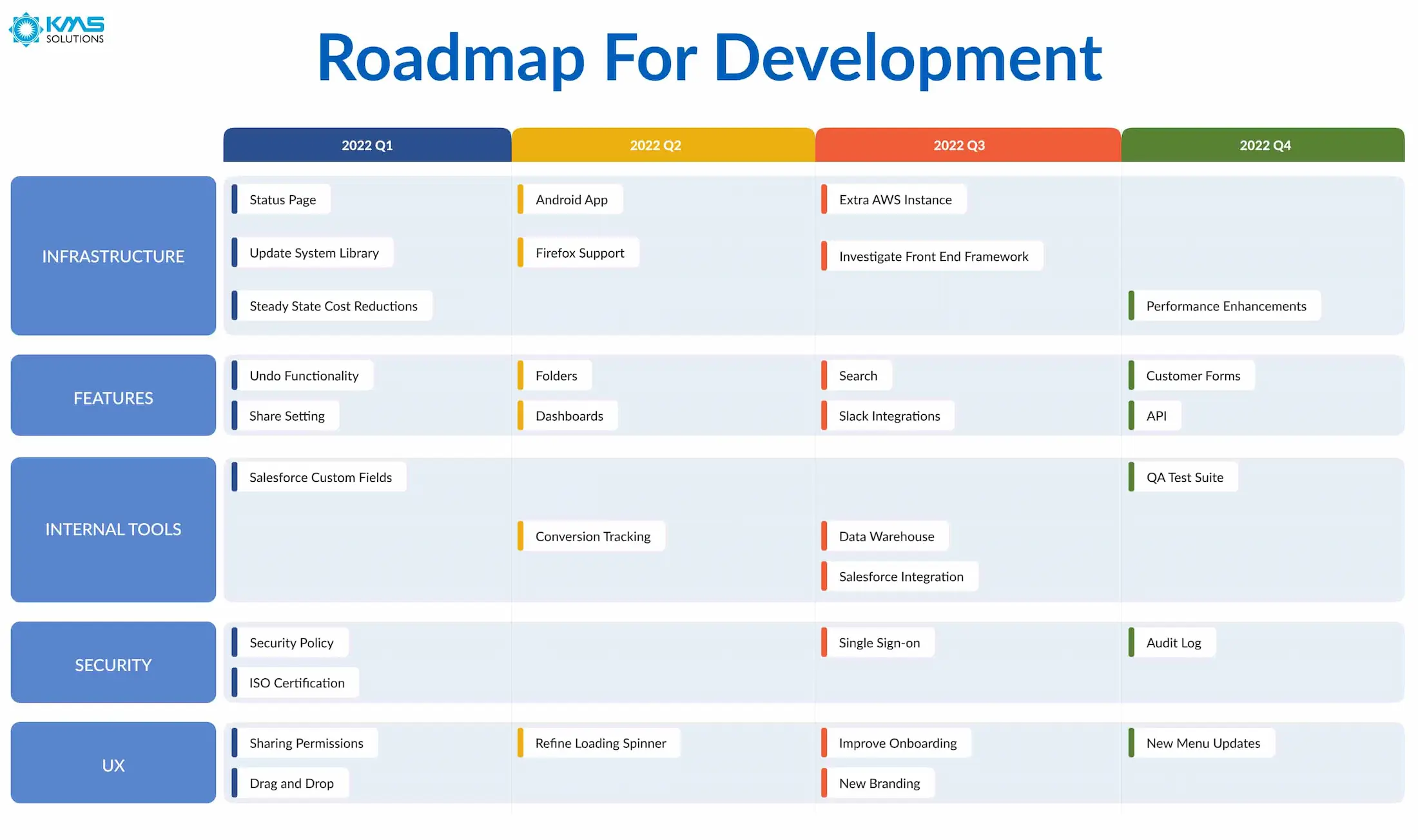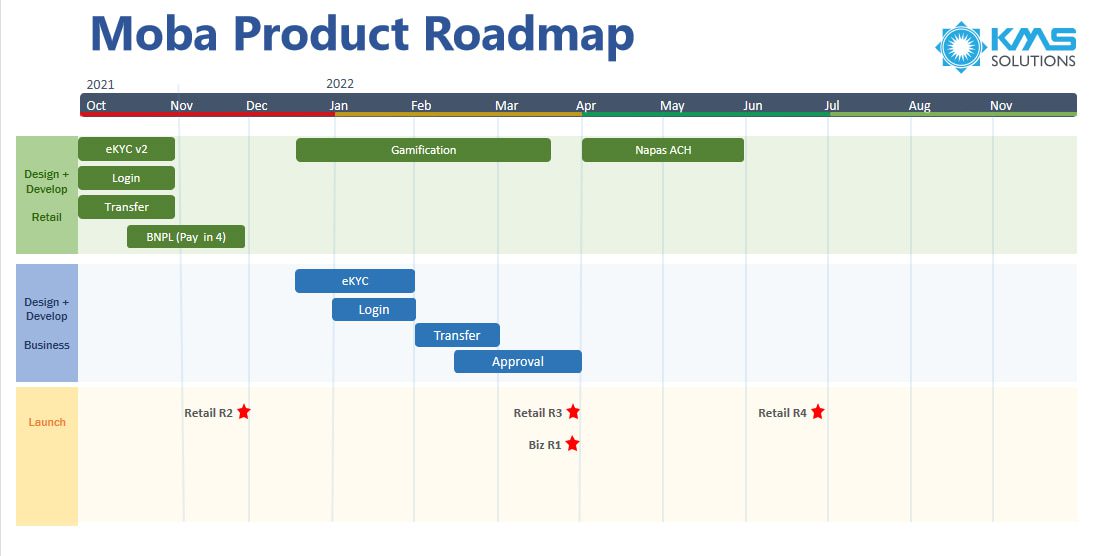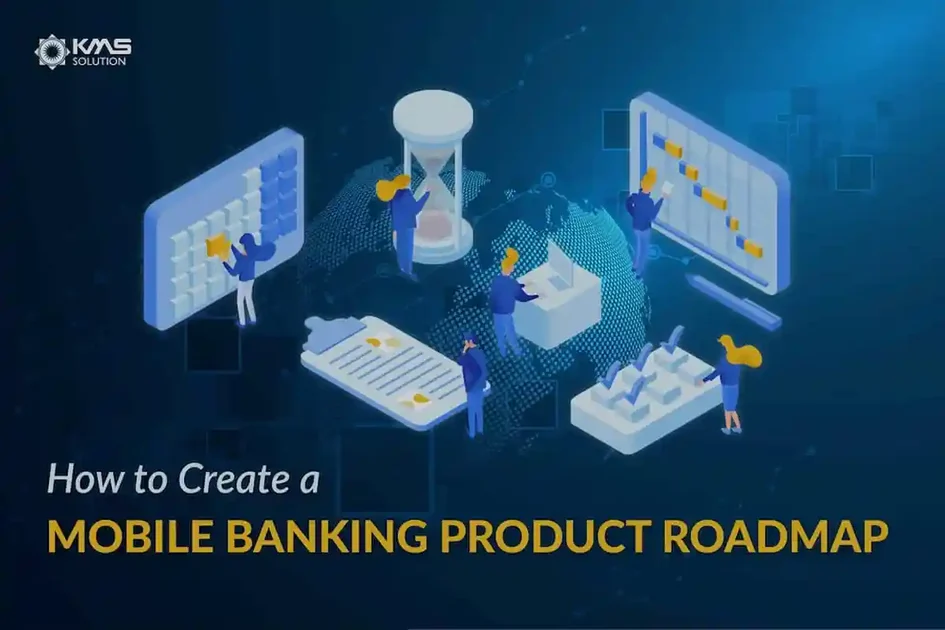Since the dawn of technology, people have become conventional with modern mobile banking to handle their everyday financial-related tasks, like transferring money, depositing a check, or many more other features that banks provide customers. Mobile has now become a vital channel for banks to reach their customers, and it currently has the highest levels of management’s attention. So, it’s indisputable to say that mobile banking is staying on top of evolving market trends. However, how to manage the mobile application development process is still a question. Just like driving in an unknown city without a map, developing an application with no product map could end up getting lost or developing in circles.
What is the Product Roadmap?
A product roadmap is a high-level visual, strategic document summary that reflects the vision and direction of the product’s development. In basic terms, it includes a list of products’ prioritized features or requirements that are needed to complete according to the estimated timeline.
Typically, a mobile app development roadmap resembles a horizontal bar chart that concurrently demonstrates both the progress and timeline for various initiatives and tasks.
Several ultimate goals of the product roadmap could be named:
- Illustrate the product strategy and vision;
- Provide a guiding document for operating strategy;
- Get alignment from the stakeholders;
- Facilitate conversation around scenario planning;
- Communicate with customers, including stakeholders.
In addition, the product roadmap must be clear and easy to understand. This helps the product manager – who is ultimately responsible for the product roadmap – guide the teams through the development process and stay away from misunderstanding each other.
Types of Product Roadmap
Basically, there are four types of product roadmap, each of which presents to a specific audience group. Hence, identifying that group of audience beforehand can help you tailor the content concentration and presentation to fit their demands. Now let’s explore it one by one.
1. Internal roadmap for executives
These roadmaps should concentrate on high-level strategic concepts such as driving growth, new market incursion, customer contentment, or market situation.
They are often tracked monthly or quarterly to analyze progress over time toward company objectives and normally comprise less detail about a particular story or task.
2. Internal roadmap for the development teams
Features, releases, sprints, and milestones are mainly focused on these roadmaps. In comparison to executive-level roadmaps, they are typically more detailed in scope and shorter in duration. Moreover, these roadmaps contain a lot of detailed information about the project, such as prioritized customer value to be delivered, target release date, and milestones.
For those adopting Agile development methodologies, these roadmaps are often at the epic or feature level and organized by sprint. Furthermore, product goals and themes are included in these roadmaps as well.

3. Internal roadmap for sales
To know how the product will help them increase sales, on these roadmaps, the sales team focuses on a combination of features and customer benefits. Since sales teams typically share these roadmaps with customers as a way of closing deals or keeping leads warm, it’s crucial to avoid mentioning a specific release or launch date.

4. External roadmap for customers
Since these product roadmaps are designed for customers, they should excite prospects about the product’s benefit. Perhaps, the major readers of these roadmaps are non-technical, customer roadmaps should be visual, attractive, and easy to understand.
Same as a sales roadmap, it’s a best practice not to include the release or launch dates in external-facing roadmaps to avoid the risk of over-commitment to customers.

Why are product roadmaps for banking apps important?
The product roadmap’s most significant value is the strategic vision it provides to all stakeholders, from product managers and developers to customers. When a robust product mapping process is established, it benefits the development team in several aspects, including:
- The comprehensive picture of the development process: The development roadmap provides software engineers with insights regarding how their development efforts contribute to the primary business goals and, from that, prioritize their tasks.
- Improved communication and collaboration with external stakeholders: Through these roadmaps, feature priorities are communicated effectively to the investor. The feedback from stakeholders is also valuable for improving the app.
- Easy-to-follow product vision and strategy: The goals and directions of the product are laid out in detail in roadmaps for the teams to better understand their responsibilities. Furthermore, as these roadmaps are expressed in different ways, non-technical team members such as designers and sales managers can also find those engineers’ tasks easy to understand.
- Effectively team communication: The roadmaps are used by the cross-functional teams to monitor the current work status and keep track of all the product changes. This helps to identify any tasks that are possibly belated quickly.
Five steps to build an effective roadmap for mobile application
Creating and maintaining a product roadmap requires a lot of effort and attention as it requires sufficient information but is not overwhelmed with unnecessary one. Here is a step-by-step guide that you should follow to create an easy-to-understand and effective roadmap for your banking app:
1. Express a product vision
Before jumping to create a mobile banking app, defining why and for whom the product is developed is necessary to ensure that it’s worth spending time and money on. The following questions will provide you with a clear understanding of the product vision:
- What value will my mobile application bring to users?
- When will this product be launched?
- By developing a product roadmap, what kind of business goal do I want to achieve?
- What pain points can my product resolve?
In general, this step will serve as a foundation for setting product goals and initiatives.
2. Set measurable product goals
With the defined visions above, this step is to specify goals and initiatives that are aligned with that vision.
Goals help to measure the team’s success in terms of app development. If goals are both clear and viable to team members, they may be more motivated and productive towards the specific goals.
The initiatives are also analyzed in this step. They refer to all of the tasks that you need to complete to achieve your goal. Each initiative should contain product features. By associating each feature with the initiative, you can track the development of your mobile app over time and evaluate your team’s success in relation to the product’s objectives.
3. Prioritize application features
When all the product’s goals and initiatives are well-defined, it’s time to identify those application features that bring the most value to your customers. Creating a bunch of user stories beforehand is worth considering to show you a clear idea of what development efforts will result.
This practice enables product managers to prioritize critical features to deliver first or spot potential functionality that can be delivered in the future. Apart from that, the development team can detect the blockers and dependencies through this stage to successfully deploy the product.
4. Define the comprehensive set of timeframes
The ability to track current progress is vital for the success of the mobile application development process. In order to achieve continuous improvement and development of your product, you should stick to the schedule for each iteration, which is commonly two weeks in agile.
Moreover, the plan to execute required to be broad enough for the team to have innovation and flexibility, but there are still some general deadlines to hit.
5. Select appropriate tools
Traditionally, Excel was the leading tool for road mapping, but now, a considerable amount of software, which is using cloud-based, has emerged to help the development team successfully create an effective product roadmap. Based on your need, whether the waterfall roadmap or agile product development roadmap is supported by common tools like OpenProject, Product Plan, Aha! Or Roadmunk.
How did KMS Solutions help build a banking app roadmap?

By partnering with KMS Solutions, banks and financial institutions are advised thoroughly about the strategic product roadmap for mobile banking app development.
Firstly, we will have a meeting with banks to discuss the challenges they’re confronting and their strategies to have the must appropriate plan regarding the problem that the desired mobile app will resolve. Besides, as buyer persona will play an important role in defining the app’s features, it should be done carefully through research or customer interviews.
Based on the defined product goals, we will create a list of features banks want to include and then start ranking and prioritizing to keep the app development lean. By implementing the MoSCow method, we will help clients categorize features based on their attributes: must-have, should, could, and won’t. Above all, must-have features for banking will need to be included in the first version of the mobile banking app, and then after are innovative features that banks should consider to improve customer experience.
The product roadmap will then be created based on the necessary features, all tasks needed to be done, and specific timeframes or milestones to hit. The specific deadline for tasks will make team members commit to promises and release on time. Moreover, in every sprint of the development, we will have a discussion with banks to report our working progress to ensure the time-to-market of the mobile banking app.
Conclusion
Thanks to the product roadmap, communication and coordination within teams could be improved. It helps to navigate through the entire process of application development and indicate where the teams are, how well they are progressing, and which features need to deliver first to meet the strategic goals and product vision.
This ultimate guide to building a product roadmap will help your teams deploy your solution to the market stress-free while also achieving all strategic business goals. If you are planning to build a banking product for yourself, let’s talk.












